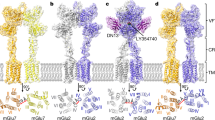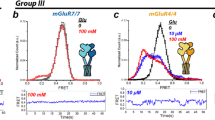Abstract
The metabotropic glutamate receptors (mGluRs) are key receptors in the modulation of excitatory synaptic transmission in the central nervous system. Here we have determined three different crystal structures of the extracellular ligand-binding region of mGluR1—in a complex with glutamate and in two unliganded forms. They all showed disulphide-linked homodimers, whose ‘active’ and ‘resting’ conformations are modulated through the dimeric interface by a packed α-helical structure. The bi-lobed protomer architectures flexibly change their domain arrangements to form an ‘open’ or ‘closed’ conformation. The structures imply that glutamate binding stabilizes both the ‘active’ dimer and the ‘closed’ protomer in dynamic equilibrium. Movements of the four domains in the dimer are likely to affect the separation of the transmembrane and intracellular regions, and thereby activate the receptor. This scheme in the initial receptor activation could be applied generally to G-protein-coupled neurotransmitter receptors that possess extracellular ligand-binding sites.
This is a preview of subscription content, access via your institution
Access options
Subscribe to this journal
Receive 51 print issues and online access
$199.00 per year
only $3.90 per issue
Buy this article
- Purchase on Springer Link
- Instant access to full article PDF
Prices may be subject to local taxes which are calculated during checkout





Similar content being viewed by others
References
Nakanishi, S. & Masu, M. Molecular diversity and functions of glutamate receptors. Annu. Rev. Biophys. Biomol. Struct. 23, 319–348 (1994).
Hollmann, M. & Heinemann, S. Cloned glutamate receptors. Annu. Rev. Neurosci. 17, 31–108 (1994).
Nakanishi, S. Molecular diversity of glutamate receptors and implications for brain function. Science 258, 597–603 (1992).
Brown, E. M. et al. Cloning and characterization of an extracellular Ca2+-sensing receptor from bovine parathyroid. Nature 366, 575–580 (1993).
Herrada, G. & Dulac, C. A novel family of putative pheromone receptors in mammals with a topographically organized and sexually dimorphic distribution. Cell 90, 763– 773 (1997).
Matsunami, H. & Buck, L. B. A multigene family encoding a diverse array of putative pheromone receptors in mammals. Cell 90, 775–784 (1997).
O'Hara, P. J. et al. The ligand-binding domain in metabotropic glutamate receptors is related to bacterial periplasmic binding proteins. Neuron 11, 41–52 (1993).
Kaupmann, K. et al. Expression cloning of GABAB receptors uncovers similarity to metabotropic glutamate receptors. Nature 386, 239–246 (1997).
Takahashi, K., Tsuchida, K., Tanabe, Y., Masu, M. & Nakanishi, S. Role of the large extracellular domain of metabotropic glutamate receptors in agonist selectivity determination. J. Biol. Chem. 268, 19341–19345 ( 1993).
Costantino, G., Macchiarulo A. & Pellicciari, R. Modeling of amino-terminal domains of group I metabotropic glutamate receptors: structural motifs affecting ligand selectivity. J. Med. Chem. 42, 5390–5401 (1999).
Sack, J. S., Saper, M. A. & Quiocho, F. A. Periplasmic binding protein structure and function. Refined X-ray structures of the leucine/isoleucine/valine-binding protein and its complex with leucine. J. Mol. Biol. 206, 171–191 (1989).
Okamoto, T. et al. Expression and purification of the extracellular ligand binding region of metabotropic glutamate receptor subtype 1. J. Biol. Chem. 273, 13089–13096 ( 1998).
Han, G. -M. & Hampson, D. R. Ligand binding to the amino-terminal domain of the mGluR4 subtype of metabotropic glutamate receptor. J. Biol. Chem. 274, 10008–10013 (1999).
Goldsmith, P. K. et al. Expression, purification, and biochemical characterization of the amino-terminal extracellular domain of the human calcium receptor. J. Biol. Chem. 274, 11303– 11309 (1999).
Tsuji, Y. et al. Cryptic dimer interface and domain organization of the extracellular region of metabotropic glutamate receptor subtype 1. J. Biol. Chem. 275, 28144–28151 ( 2000)
Romano, C., Yang, W.-L. & O'Malley, K. L. Metabotropic glutamate receptor 5 is a disulphide-linked dimer. J. Biol. Chem. 271, 28612– 28616 (1996).
Armstrong, N., Sun, Y., Chen, G.-Q. & Gouaux, E. Structure of a glutamate-receptor ligand-binding core in complex with kainate. Nature 395, 913–917 ( 1998).
Oh, B.-H. et al. Three-dimensional structures of the periplasmic lysine/arginine/ornithine-binding protein with and without a ligand. J. Biol. Chem. 268 , 11348–11355 (1993).
Sugiyama, S. et al. Crystal structure of PotD, the primary receptor of the polyamine transport system in Escherichia coli. J. Biol. Chem. 271, 9519–9525 (1996).
Vassylyev, D. G., Tomitori, H., Kashiwagi, K., Morikawa, K. & Igarashi, K. Crystal structure and mutational analysis of the Escherichia coli putrescine receptor. J. Biol. Chem. 273, 17604–17609 (1998).
Sun, Y.-J., Rose, J., Wang, B.-C. & Hsiao, C.-D. The structure of glutamine-binding protein complexed with glutamine at 1.94 Å resolution: comparisons with other amino acid binding proteins. J. Mol. Biol. 278, 219–229 ( 1998).
Kubo, Y., Miyashita, T. & Murata, Y. Structural basis for a Ca2+-sensing function of the metabotropic glutamate receptors. Science 279 , 1722–1725 (1998).
Gallivan, J. P. & Dougherty, D. A. Cation–π interactions in structural biology. Proc. Natl. Acad. Sci. USA 96, 9459–9464 ( 1999).
Hampson, D. R. et al. Probing the ligand-binding domain of the mGluR4 subtype of metabotropic glutamate receptor. J. Biol. Chem. 274 , 33488–33495 (1999).
Chothia, C., Levitt, M. & Richardson, D. Structure of proteins: packing of α-helices and pleated sheets. Proc. Natl. Acad. Sci. USA 74, 4130–4134 (1977).
Khorana, H. G. Rhodopsin, photoreceptor of the rod cell: an emerging pattern for structure and function. J. Biol. Chem. 267, 1– 4 (1992).
Strader, C. D., Fong, T.-M., Tota, M. R., Underwood, D. & Dixon, R. A. F. Structure and function of G protein-coupled receptors. Annu. Rev. Biochem. 63, 101– 132, (1994).
Aritomi, M. et al. Atomic structure of the GCSF-receptor complex showing a new cytokine-receptor recognition scheme. Nature 401, 713–717 (1999).
Deller, M. C. & Jones, E. Y. Cell surface receptors. Curr. Opin. Struct. Biol. 10, 213– 219 (2000).
Livnah, O. et al. Crystallographic evidence for preformed dimers of erythropoietin receptor before ligand activation. Science 283, 987–990 (1999).
Remy, I., Wilson, I. A. & Minchnick, S. W. Erythropoietin receptor activation by a ligand-induced conformation change. Science 283, 990– 993 (1999).
Jones, K. A. et al. GABAB receptors function as a heteromeric assembly of the subunits GABABR1 and GABABR2. Nature 396, 674–679 ( 1998).
White, J. H. et al. Heterodimerization is required for the formation of a functional GABAB receptor. Nature 396, 679 –682 (1998).
Kaupmann, K. et al. GABAB-receptor subtypes assemble into functional heteromeric complexes. Nature 396, 683– 687 (1998).
Otwinowski, Z. & Minor, W. Processing of X-ray diffraction data collected in oscillation mode. Methods Enzymol. 276, 307–326 ( 1997).
de La Fortelle, E. & Bricogne, G. Maximum-likelihood heavy-atom parameter refinement for multiple isomorphous replacement and multiwavelength anomalous diffraction methods. Methods Enzymol. 276 , 472–494 (1997).
Collaborative Computational Project, Number 4. The CCP4 Suite: programs for protein crystallography. Acta Crystallogr. D 50, 760–763 (1994).
Brünger, A. T. et al. Crystallography & NMR system: a new software suite for macromolecular structure determination. Acta Crystallogr. D 54, 905–921 (1998).
Weik, M. et al. Specific chemical and structural damage to proteins produced by synchrotron radiation. Proc. Natl. Acad. Sci. USA 97, 623–628 (2000).
Masu, M., Tanabe, Y., Tsuchida, K., Shigemoto, R. & Nakanishi, S. Sequence and expression of a metabotropic glutamate receptor. Nature 349, 760– 765 (1991).
Flor, P. J. et al. Molecular cloning, functional expression and pharmacological characterization of the human metabotropic glutamate receptor type 2. Eur. J. Neurosci. 7, 622–629 (1995).
Minakami, R., Katsuki, F., Yamamoto, T., Nakamura, K. & Sugiyama, H. Molecular cloning and the functional expression of two isoforms of human metabotropic glutamate receptor subtype 5. Biochem. Biophys. Res. Commun. 199, 1136 –1143 (1994).
Hashimoto, T. et al. The whole nucleotide sequence and chromosomal localization of the gene for human metabotropic glutamate receptor subtype 6. Eur. J. Neurosci. 9, 1226–1235 (1997).
Garrett, J. E. et al. Molecular cloning and functional expression of human parathyroid calcium receptor cDNAs. J. Biol. Chem. 270, 12919–12925 (1995).
Nicholls, A., Sharp, K. A. & Honig, B. Protein folding and association: insights from the interfacial and thermodynamic properties of hydrocarbons. Proteins 11, 281–296 (1991).
Kyte, J. & Doolittle, R. F. A simple method for displaying the hydropathic character of a protein. J. Mol. Biol. 157, 105–132 (1982).
Acknowledgements
We thank N. Yagi and Y. Katsuya for use of the facilities at SPring-8, Hyogo, Japan. We also thank T. Tomura and S. Yamamoto for technical assistance; H. Toh and T. Hiroike for their help in bioinformatic analyses; and Y. Shimura, H. Nakamura and A. Pähler for discussions and encouragement. This study is partly supported by a grant from the SPring-8 Joint Research Promotion Scheme of the Japan Science and Technology Corporation.
Author information
Authors and Affiliations
Corresponding author
Rights and permissions
About this article
Cite this article
Kunishima, N., Shimada, Y., Tsuji, Y. et al. Structural basis of glutamate recognition by a dimeric metabotropic glutamate receptor. Nature 407, 971–977 (2000). https://doi.org/10.1038/35039564
Received:
Accepted:
Issue Date:
DOI: https://doi.org/10.1038/35039564
This article is cited by
-
Allosteric modulation of the fish taste receptor type 1 (T1R) family by the extracellular chloride ion
Scientific Reports (2023)
-
Prediction of dynamic allostery for the transmembrane domain of the sweet taste receptor subunit, TAS1R3
Communications Biology (2023)
-
Kinetic fingerprinting of metabotropic glutamate receptors
Communications Biology (2023)
-
Glutamate and GABAA receptor crosstalk mediates homeostatic regulation of neuronal excitation in the mammalian brain
Signal Transduction and Targeted Therapy (2022)
-
Coordination chemogenetics for activation of GPCR-type glutamate receptors in brain tissue
Nature Communications (2022)
Comments
By submitting a comment you agree to abide by our Terms and Community Guidelines. If you find something abusive or that does not comply with our terms or guidelines please flag it as inappropriate.



